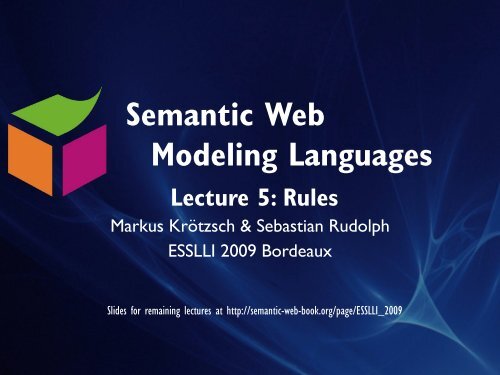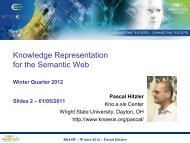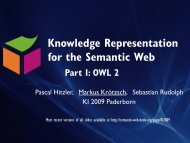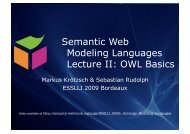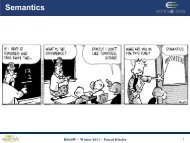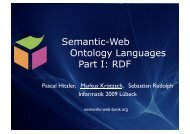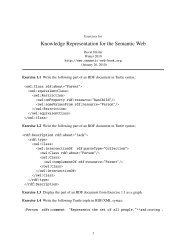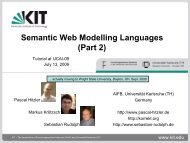Lecture 5 - Foundations of Semantic Web Technologies
Lecture 5 - Foundations of Semantic Web Technologies
Lecture 5 - Foundations of Semantic Web Technologies
You also want an ePaper? Increase the reach of your titles
YUMPU automatically turns print PDFs into web optimized ePapers that Google loves.
<strong>Semantic</strong> <strong>Web</strong><br />
Modeling Languages<br />
<strong>Lecture</strong> 5: Rules<br />
Markus Krötzsch & Sebastian Rudolph<br />
ESSLLI 2009 Bordeaux<br />
Slides for remaining lectures at http://semantic-web-book.org/page/ESSLLI_2009
Why Rules?<br />
OWL may not suffice for all applications<br />
• There are statements that cannot be expressed in OWL<br />
(cf. <strong>Lecture</strong> 4)<br />
• Modeling constructs <strong>of</strong> OWL not always adequate or most<br />
desirable<br />
• First-order logic in general may be insufficient (e.g. if non-monotonic<br />
negation is desired)<br />
→ “ Rules” as an alternative paradigm for knowledge modeling<br />
Markus Krötzsch, Sebastian Rudolph: <strong>Semantic</strong> <strong>Web</strong> Modeling Languages, ESSLLI 2009, Bordeaux<br />
semantic-web-book.org<br />
2
What is a Rule?<br />
• Logical Rules (predicate logic implications)<br />
– “F → G” (equivalent to “¬F v G”)<br />
– Logical extension <strong>of</strong> a knowledge base (static)<br />
– Open World<br />
– Declarative (descriptive)<br />
• Procedural Rules (e.g. production rules)<br />
– “If X then Y else Z”<br />
– Executable machine directive (dynamic)<br />
– Operational (meaning = effect on execution)<br />
• Logic Programming (e.g. Prolog, F-Logic)<br />
– “man(x) :- person(X), not woman(X)”<br />
– Approximating logical semantics with procedural aspects, built-ins possible<br />
– Typically Closed World<br />
– “semi-declarative”<br />
• Deduction rules <strong>of</strong> a calculus (e.g. rules for RDF semantics, lecture 1)<br />
– Rules not part <strong>of</strong> the knowledge base, “meta-rules”<br />
Markus Krötzsch, Sebastian Rudolph: <strong>Semantic</strong> <strong>Web</strong> Modeling Languages, ESSLLI 2009, Bordeaux<br />
semantic-web-book.org<br />
3
Which Rule Language?<br />
Rule languages are hardly compatible with each other →<br />
important to chose adequate rule language<br />
Possible criteria:<br />
– Clear specification <strong>of</strong> syntax and semantics?<br />
– Support by s<strong>of</strong>tware tools?<br />
– Which expressive features are needed?<br />
– Complexity <strong>of</strong> implementation? Performance?<br />
– Compatibility with other formats, e.g. OWL?<br />
– Declarative (describing) or operational (programming)?<br />
– …<br />
Markus Krötzsch, Sebastian Rudolph: <strong>Semantic</strong> <strong>Web</strong> Modeling Languages, ESSLLI 2009, Bordeaux<br />
semantic-web-book.org<br />
4
Which Rule Language?<br />
• Logical Rules (predicate logic implications)<br />
– Clearly defined, extensively researched, well understood<br />
– Very well compatible with OWL and RDF<br />
– Not decidable if unrestricted<br />
• Procedural Rules (e.g. production rules)<br />
– Many independent approaches, vague definition<br />
– Used like programming languages, relation to RDF and OWL not clear<br />
– Efficient processing possible<br />
• Logic Programming (e.g. Prolog, F-Logic)<br />
– Clearly defined, but many independent approaches<br />
– Partly compatible with OWL and RDF<br />
– Decidability/complexity depends very much on the chosen approach<br />
→ In this lecture: predicate logic rules<br />
(which are also the basis for logic programming)<br />
Markus Krötzsch, Sebastian Rudolph: <strong>Semantic</strong> <strong>Web</strong> Modeling Languages, ESSLLI 2009, Bordeaux<br />
semantic-web-book.org<br />
5
Predicate Logic as a Rule Language<br />
•<br />
Rules as first-order logic implications (Horn clauses):<br />
A1 ∧ A2 ∧ . . . ∧ An → H (“Body → Head”)<br />
Example: “Man(x) ∧ happilyMarriedWith(x,y) → HappyHusband(x)”<br />
•<br />
Constants, variables, function symbols can be used; but no negation<br />
•<br />
Quantifiers are omitted: free variables considered universally quantified<br />
•<br />
Datalog: rules without function symbols<br />
–<br />
Originally developed for deductive databases<br />
–<br />
Knowledge bases (“datalog programs”) are sets <strong>of</strong> function-free Horn clauses<br />
– Decidable<br />
–<br />
efficiently implementable for large datasets (overall complexity ExpTime, i.e.<br />
“Draughts” or “Chess”)<br />
Markus Krötzsch, Sebastian Rudolph: <strong>Semantic</strong> <strong>Web</strong> Modeling Languages, ESSLLI 2009, Bordeaux<br />
semantic-web-book.org<br />
6
<strong>Semantic</strong>s <strong>of</strong> Datalog?<br />
• <strong>Semantic</strong>s follows from first-order logic:<br />
– Generally well-known<br />
– Compatible with other first-order fragments, e.g. description<br />
logics ( → OWL)<br />
Note: to maintain this relationship, we will prefer FOL<br />
syntax “hasCat(x,y)” over Turtle style “x hasCat y” or<br />
“triple(x,hasCat,y).”<br />
Markus Krötzsch, Sebastian Rudolph: <strong>Semantic</strong> <strong>Web</strong> Modeling Languages, ESSLLI 2009, Bordeaux<br />
semantic-web-book.org<br />
7
SWRL<br />
How can datalog and OWL be combined?<br />
SWRL – <strong>Semantic</strong> <strong>Web</strong> Rule Language [swirl]<br />
• Proposal for a rule extension for OWL (W3C member<br />
submission)<br />
• Idea: datalog rules referring to an OWL ontology<br />
→ Symbols in rules can be OWL identifiers or new symbols<br />
• Various further features and syntactic forms (not relevant<br />
here)<br />
Markus Krötzsch, Sebastian Rudolph: <strong>Semantic</strong> <strong>Web</strong> Modeling Languages, ESSLLI 2009, Bordeaux<br />
semantic-web-book.org<br />
8
<strong>Semantic</strong>s <strong>of</strong> SWRL<br />
Combined semantics OWL DL + datalog?<br />
→ use first-order mapping <strong>of</strong> OWL (lecture 2)<br />
In effect:<br />
– OWL individuals are datalog constants<br />
– OWL classes are unary datalog predicates<br />
– OWL properties are binary datalog predicates<br />
→ A first-order interpretation can at the same time be a model<br />
for an OWL ontology and a datalog program<br />
→ Entailment over OWL+datalog (SWRL) well-defined<br />
Markus Krötzsch, Sebastian Rudolph: <strong>Semantic</strong> <strong>Web</strong> Modeling Languages, ESSLLI 2009, Bordeaux<br />
semantic-web-book.org<br />
9
Example: SWRL knowledge base<br />
For readability, we abbreviate URIs strongly here; the datalog syntax does not follow a<br />
formal specification (SWRL XML is too verbose here)<br />
(1) Vegetarian(x) ∧ Fishproduct(y) → dislikes(x,y)<br />
(2) ordered(x,y) ∧ dislikes(x,y) → Unhappy(x)<br />
(3) ordered(x,y) → Dish(y)<br />
(4) dislikes(x,z) ∧ Dish(y) ∧ contains(y,z) → dislikes(x,y)<br />
(5) → Vegetarian(markus)<br />
(6) Happy(x) ∧ Unhappy(x) →<br />
(7) markus rdf:type [<br />
rdf:type<br />
owl:Restriction;<br />
owl:onProperty ordered;<br />
owl:someValuesFrom ThaiCurry ]<br />
(8) ThaiCurry rdfs:subClassOf [<br />
rdf:type<br />
owl:Restriction;<br />
owl:onProperty contains;<br />
owl:someValuesFrom Fishproduct ]<br />
Markus Krötzsch, Sebastian Rudolph: <strong>Semantic</strong> <strong>Web</strong> Modeling Languages, ESSLLI 2009, Bordeaux<br />
semantic-web-book.org<br />
10
Example: SWRL knowledge base<br />
OWL DL can be translated to first-order logic:<br />
(1) Vegetarian(x) ∧ Fishproduct(y) → dislikes(x,y)<br />
(2) ordered(x,y) ∧ dislikes(x,y) → Unhappy(x)<br />
(3) ordered(x,y) → Dish(y)<br />
(4) dislikes(x,z) ∧ Dish(y) ∧ contains(y,z) → dislikes(x,y)<br />
(5) → Vegetarian(markus)<br />
(6) Happy(x) ∧ Unhappy(x) →<br />
(7) 9y.ordered(markus,y) ∧ ThaiCurry(y)<br />
(8) 8x.ThaiCurry(x) → (9y.contains(x,y) ∧ FishProduct(y))<br />
→ <strong>Semantic</strong>s completely defined<br />
→ Expected conclusion: Unhappy(markus)<br />
Note:<br />
empty rule heads correspond to “false” (rule body must never be true)<br />
empty rule bodies correspond to “true” (rule head must always be true)<br />
Markus Krötzsch, Sebastian Rudolph: <strong>Semantic</strong> <strong>Web</strong> Modeling Languages, ESSLLI 2009, Bordeaux<br />
semantic-web-book.org<br />
11
How Hard is SWRL?<br />
• Deduction for OWL DL is NExpTime-complete<br />
• Deduction for OWL 2 DL is N2ExpTime-complete<br />
• Deduction in datalog is ExpTime-complete<br />
→ How hard is deduction for SWRL?<br />
Deduction for SWRL is undecidable<br />
(for OWL and thus for OWL 2, even for OWL EL)<br />
Markus Krötzsch, Sebastian Rudolph: <strong>Semantic</strong> <strong>Web</strong> Modeling Languages, ESSLLI 2009, Bordeaux<br />
semantic-web-book.org<br />
12
Undecidability <strong>of</strong> SWRL<br />
SWRL is undecidable:<br />
There is no algorithm that can draw all logical conclusions from<br />
all SWRL knowledge bases, even with unlimited time and<br />
resources.<br />
Practically possible:<br />
• Algorithms that draw all conclusions for some SWRL<br />
knowledge bases<br />
• Algorithms that draw some conclusions from all SWRL<br />
knowledge bases<br />
→ Both trivial if “some” refers to very few things<br />
Markus Krötzsch, Sebastian Rudolph: <strong>Semantic</strong> <strong>Web</strong> Modeling Languages, ESSLLI 2009, Bordeaux<br />
semantic-web-book.org<br />
13
Decidable Fragments <strong>of</strong> SWRL<br />
Which classes <strong>of</strong> SWRL knowledge bases allow<br />
for complete inference algorithms?<br />
– All SWRL knowledge bases consisting only <strong>of</strong> OWL (2)<br />
axioms<br />
– All SWRL knowledge bases only consisting <strong>of</strong> datalog<br />
rules<br />
– Every fixed finite class <strong>of</strong> SWRL knowledge bases<br />
→ Which more interesting decidable fragments exist?<br />
– Description Logic Rules<br />
– DL-safe Rules<br />
Markus Krötzsch, Sebastian Rudolph: <strong>Semantic</strong> <strong>Web</strong> Modeling Languages, ESSLLI 2009, Bordeaux<br />
semantic-web-book.org<br />
14
Description Logic Rules<br />
Observation:<br />
Some SWRL-rules can already be expressed in OWL 2.<br />
• Identifying all such Description Logic Rules leads to a<br />
decidable fragment<br />
• Goal: Exploit “hidden” expressivity <strong>of</strong> OWL 2<br />
• Implementation directly by OWL 2 tools<br />
Markus Krötzsch, Sebastian Rudolph: <strong>Semantic</strong> <strong>Web</strong> Modeling Languages, ESSLLI 2009, Bordeaux<br />
semantic-web-book.org<br />
15
Simple Rules in OWL 2: Examples<br />
• Simple OWL 2 axioms correspond to rules:<br />
Class1 rdfs:subClassOf Class2 .<br />
Property1 rdfs:subPropertyOf Property2 .<br />
correspond to<br />
Class1(x) → Class2(x)<br />
Property1(x,y) → Property2(x,y) .<br />
Markus Krötzsch, Sebastian Rudolph: <strong>Semantic</strong> <strong>Web</strong> Modeling Languages, ESSLLI 2009, Bordeaux<br />
semantic-web-book.org<br />
16
Simple Rules in OWL 2: Examples<br />
• Some classes can be decomposed in rules:<br />
[ owl:intersectionOf ( Happy Unhappy ) ]<br />
rdfs:subClassOf owl:Nothing .<br />
[ rdf:type owl:Restriction;<br />
owl:onProperty livesIn;<br />
owl:someValuesFrom [ rdf:type owl:Restriction;<br />
owl:onProperty locatedIn;<br />
owl:someValuesFrom EUCountry ]<br />
]<br />
] rdfs:subClassOf EUCitizen .<br />
correspond to<br />
Happy(x) ∧ Unhappy(x) →<br />
livesIn(x,y) ∧ locatedIn(y,z) ∧ EUCountry(z) → EUCitizen(x)<br />
Markus Krötzsch, Sebastian Rudolph: <strong>Semantic</strong> <strong>Web</strong> Modeling Languages, ESSLLI 2009, Bordeaux<br />
semantic-web-book.org<br />
17
Simple Rules in OWL 2: Examples<br />
• Property chains provide further rule-like axioms:<br />
hasUncle owl:PropertyChainAxiom ( hasParent hasBrother ).<br />
correspond to<br />
hasParent(x,y) ∧ hasBrother(y,z) → hasUncle(x,z)<br />
→ In all examples, mapping can also be inverted (expressing rules in OWL 2)<br />
Markus Krötzsch, Sebastian Rudolph: <strong>Semantic</strong> <strong>Web</strong> Modeling Languages, ESSLLI 2009, Bordeaux<br />
semantic-web-book.org<br />
18
More Rules (1)<br />
What about the following?<br />
dislikes(x,z) ∧ Dish(y) ∧ contains(y,z) → dislikes(x,y)<br />
• Rule head with two variables → not representable by subclass<br />
axiom<br />
• Rule body contains class expression → not representable by<br />
subproperty axiom<br />
Yet, this rule can be encoded using OWL 2!<br />
Markus Krötzsch, Sebastian Rudolph: <strong>Semantic</strong> <strong>Web</strong> Modeling Languages, ESSLLI 2009, Bordeaux<br />
semantic-web-book.org<br />
19
More Rules (2)<br />
Simpler example:<br />
Man(x) ∧ hasChild(x,y) → fatherOf(x,y)<br />
Idea: replace Man(x) by a property expression to encode rule as property chain<br />
• Self can be used to transform classes to properties:<br />
– Auxiliary property PMan<br />
– Auxiliary axiom:<br />
Man owl:equivalentClass [ rdf:type owl:Restriction;<br />
owl:onProperty PMan; owl:hasSelf “true”^^xsd:boolean ].<br />
– “Men are exactly those things that have an PMan relation to themselves.”<br />
We can now encode the rule as follows:<br />
fatherOf owl:propertyChainAxiom ( PMan hasChild ) .<br />
Markus Krötzsch, Sebastian Rudolph: <strong>Semantic</strong> <strong>Web</strong> Modeling Languages, ESSLLI 2009, Bordeaux<br />
semantic-web-book.org<br />
20
More Rules (3)<br />
dislikes(x,z) ∧ Dish(y) ∧ contains(y,z) → dislikes(x,y)<br />
becomes<br />
Dish owl:equivalentClass [ rdf:type owl:Restriction;<br />
owl:onProperty PDish; owl:hasSelf “true”^^xsd:boolean ].<br />
dislikes owl:propertyChainAxiom<br />
( dislikes [owl:inverseOf contains] PDish ).<br />
Markus Krötzsch, Sebastian Rudolph: <strong>Semantic</strong> <strong>Web</strong> Modeling Languages, ESSLLI 2009, Bordeaux<br />
semantic-web-book.org<br />
21
More Rules (4)<br />
Not so simple:<br />
Vegetarian(x) ∧ Fishproduct(y) → dislikes(x,y)<br />
Idea: use owl:topObjectProperty for linking unconnected rule body parts<br />
• Self can be used to transform classes to properties:<br />
– Auxiliary properties PVegetarian and PFishproduct<br />
– Axioms:<br />
Vegetarian owl:equivalentClass [<br />
rdf:type owl:Restriction; owl:onProperty PVegetarian;<br />
owl:hasSelf “true”^^xsd:boolean ].<br />
Fishproduct owl:equivalentClass [<br />
rdf:type owl:Restriction; owl:onProperty PFishproduct;<br />
owl:hasSelf “true”^^xsd:boolean ].<br />
dislikes owl:propertyChainAxiom<br />
( PVegetarian owl:topObjectProperty PFishproduct ).<br />
Markus Krötzsch, Sebastian Rudolph: <strong>Semantic</strong> <strong>Web</strong> Modeling Languages, ESSLLI 2009, Bordeaux<br />
semantic-web-book.org<br />
22
Limits <strong>of</strong> Description Logic Rules<br />
Not all rules can be encoded like this! Example:<br />
ordered(x,y) ∧ dislikes(x,y) → Unhappy(x)<br />
Overview <strong>of</strong> possible transformations:<br />
– Inverting properties<br />
– “Rolling-up” side branches, e.g.<br />
locatedIn(x,y) ∧ EUCountry(y)<br />
becomes<br />
[ rdf:type owl:Restriction;<br />
owl:onProperty locatedIn;<br />
owl:someValuesFrom EUCountry ]<br />
– Replacing concepts by properties (using hasSelf)<br />
– Turn property conjunctions into chains<br />
Markus Krötzsch, Sebastian Rudolph: <strong>Semantic</strong> <strong>Web</strong> Modeling Languages, ESSLLI 2009, Bordeaux<br />
semantic-web-book.org<br />
23
Defining Description Logic Rules<br />
• Preparation: Normalise rule<br />
– For each occurrence (!) <strong>of</strong> an individual name n in the rule:<br />
Use a fresh variable x, add [owl:oneOf n](x) to rule body, and replace<br />
the occurrence <strong>of</strong> n by x.<br />
– Replace every atom P(x,x) by<br />
[rdf:type owl:Restriction; owl:onProperty P;<br />
owl:hasSelf “true”^^xsd:boolean](x).<br />
• Dependency graph <strong>of</strong> a rule: undirected graph where<br />
– Nodes = variables <strong>of</strong> a rule<br />
– Edges = property atoms <strong>of</strong> a rule (direction is ignored)<br />
• A SWRL rule is a Description Logic Rule if:<br />
– All rule atoms use OWL 2 class and property names only<br />
– The normalised rule's dependency graph has no cycles<br />
Markus Krötzsch, Sebastian Rudolph: <strong>Semantic</strong> <strong>Web</strong> Modeling Languages, ESSLLI 2009, Bordeaux<br />
semantic-web-book.org<br />
24
Example<br />
(1) Vegetarian(x) ∧ Fishproduct(y)<br />
(2) ordered(x,y) ∧ dislikes(x,y)<br />
→ dislikes(x,y)<br />
→ Unhappy(x)<br />
(3) ordered(x,y) → Dish(y)<br />
(4) dislikes(x,z) ∧ Dish(y) ∧ contains(y,z) → dislikes(x,y)<br />
(5) → Vegetarian(markus)<br />
(6) Happy(x) ∧ Unhappy(x)<br />
→<br />
Note: Restrictions like regularity and simplicity must still be satisfied after the<br />
translations.<br />
Markus Krötzsch, Sebastian Rudolph: <strong>Semantic</strong> <strong>Web</strong> Modeling Languages, ESSLLI 2009, Bordeaux<br />
semantic-web-book.org<br />
25
Transforming DL Rules to OWL 2<br />
Input: A Description Logic Rule<br />
(1) Normalise the rule.<br />
(2) For every variable z in the head: if z is not in body, add owl:Thing(z) to body.<br />
(3) For every pair <strong>of</strong> variables x and y:<br />
If x is not reachable from y in the dependency graph, insert<br />
owl:topObjectProperty(x,y) into the rule<br />
(4) The rule head must have a form D(z) or S(z,z').<br />
For every atom R(x,y) in the rule body:<br />
If the path from z to y is shorter than the path from z to x in the dependency graph,<br />
then replace R(x,y) with [owl:inverseOf R](y,x).<br />
(5) While the rule body contains an atom R(x,y) such that y does not occur in any<br />
other binary predicate <strong>of</strong> the rule do:<br />
– If the body contains n unary atoms C1(y), …, Cn(y) then let E denote the<br />
expression [owl:intersectionOf (C1 … Cn)] and remove C1(y), …,<br />
Cn(y) from the body. Otherwise define E to be owl:Thing.<br />
– Replace R(x,y) by: [rdf:type owl:Restriction;<br />
owl:onProperty R; owl:someValuesFrom E](x)<br />
Markus Krötzsch, Sebastian Rudolph: <strong>Semantic</strong> <strong>Web</strong> Modeling Languages, ESSLLI 2009, Bordeaux<br />
semantic-web-book.org<br />
26
Transforming DL Rules to OWL 2<br />
The rule can now be expressed in OWL 2:<br />
● If the rule head is unary, then the rule has the form C1(x) ∧ … ∧ Cn(x) → D(x)<br />
then replace it by<br />
[owl:intersectionOf (C1, …, Cn)] rdfs:subClassOf D<br />
●<br />
If the rule head is binary<br />
– For every unary atom C(z) in the rule body:<br />
Create a new axiom<br />
C owl:equivalentClass [ rdf:type owl:Restriction;<br />
owl:onProperty R; owl:hasSelf “true”^^xsd:boolean ].<br />
and replace C(z) by R(z,z), where R is a fresh property.<br />
– Rule now has the form R1(x,x2) ∧… ∧ Rn(xn,y) → S(x,y). Replace it by:<br />
S owl:propertyChainAxiom ( R1 … Rn ).<br />
Markus Krötzsch, Sebastian Rudolph: <strong>Semantic</strong> <strong>Web</strong> Modeling Languages, ESSLLI 2009, Bordeaux<br />
semantic-web-book.org<br />
27
Notes on the Transformation<br />
• Replacing a SWRL rule in a SWRL knowledge base by the<br />
resulting set <strong>of</strong> OWL 2 axioms does not affect satisfiability<br />
(introduced auxiliary symbols do not occur elsewhere, <strong>of</strong> course)<br />
• The given algorithm is not optimised: it may produce overly<br />
complex axioms in some cases<br />
Markus Krötzsch, Sebastian Rudolph: <strong>Semantic</strong> <strong>Web</strong> Modeling Languages, ESSLLI 2009, Bordeaux<br />
semantic-web-book.org<br />
28
DL-safe Rules<br />
Observation: Datalog is decidable since rules can be<br />
applied in only finitely many ways: variables represent only<br />
constants.<br />
• Variables in SWRL might represent arbitrarily many<br />
infered individuals<br />
• Goal: Make rules “safe” by restricting possible variable<br />
assignments<br />
• DL-safe rules as another decidable fragment <strong>of</strong> SWRL<br />
Markus Krötzsch, Sebastian Rudolph: <strong>Semantic</strong> <strong>Web</strong> Modeling Languages, ESSLLI 2009, Bordeaux<br />
semantic-web-book.org<br />
29
DL-safe Rules: Definition<br />
Rules now may also include non-OWL predicates:<br />
– A datalog atom is an atom with a predicate symbol that does not occur<br />
as a class or property in any OWL axiom.<br />
A SWRL rule is DL-safe if:<br />
– Every variable in the rule head occurs in a datalog atom in the body.<br />
→ Only constant symbols relevant when considering variable<br />
assignments in datalog atoms.<br />
Markus Krötzsch, Sebastian Rudolph: <strong>Semantic</strong> <strong>Web</strong> Modeling Languages, ESSLLI 2009, Bordeaux<br />
semantic-web-book.org<br />
30
Enforcing DL-Safety<br />
• Example:<br />
ordered(x,y) ∧ dislikes(x,y) → Unhappy(x)<br />
→<br />
not DL-safe if<br />
ordered or dislikes occur in OWL axioms<br />
• Enforcing DL-safety by restricting rules to named individuals:<br />
ordered(x,y) ∧ dislikes(x,y)<br />
∧ O(x) ∧ O(y) → Unhappy(x)<br />
where a fact → O(a) is added for all individuals a.<br />
→<br />
Rule only applicable to<br />
named OWL individuals<br />
Markus Krötzsch, Sebastian Rudolph: <strong>Semantic</strong> <strong>Web</strong> Modeling Languages, ESSLLI 2009, Bordeaux<br />
semantic-web-book.org<br />
31
DL-Safe Rules in Practice<br />
• OWL 2 with DL-safe rules is decidable<br />
• Naïve implementation: each rule expressible by finitely many<br />
DL rules where all variables are replaced by individual<br />
symbols in all possible ways (very inefficient)<br />
• No increase in worst-case complexity<br />
Implementations:<br />
• Basic support in some reasoners (KAON2, Pellet)<br />
• Implementation in tableau-based tools complicated<br />
Markus Krötzsch, Sebastian Rudolph: <strong>Semantic</strong> <strong>Web</strong> Modeling Languages, ESSLLI 2009, Bordeaux<br />
semantic-web-book.org<br />
32
A Combined Example<br />
OWL 2 + Description Logic Rules + DL-safe rules still decidable:<br />
(1) Vegetarian(x) ∧ Fishproduct(y) → dislikes(x,y)<br />
(2)ordered(x,y) ∧ dislikes(x,y) ∧ O(x) ∧ O(y) → Unhappy(x)<br />
(3) ordered(x,y) → Dish(y)<br />
(4) dislikes(x,z) ∧ Dish(y) ∧ contains(y,z) → dislikes(x,y)<br />
(5) → Vegetarian(markus)<br />
(6) Happy(x) ∧ Unhappy(x) →<br />
(7) markus rdf:type [<br />
rdf:type<br />
owl:Restriction;<br />
owl:onProperty ordered;<br />
owl:someValuesFrom ThaiCurry ]<br />
(8) ThaiCurry rdfs:subClassOf [<br />
rdf:type<br />
owl:Restriction;<br />
owl:onProperty contains;<br />
owl:someValuesFrom Fishproduct ]<br />
(9) → O(markus)<br />
→ We cannot conclude Unhappy(markus)<br />
Markus Krötzsch, Sebastian Rudolph: <strong>Semantic</strong> <strong>Web</strong> Modeling Languages, ESSLLI 2009, Bordeaux<br />
semantic-web-book.org<br />
33
A Combined Example<br />
Explicitly use named individual:<br />
(1) Vegetarian(x) ∧ Fishproduct(y) → dislikes(x,y)<br />
(2)ordered(x,y) ∧ dislikes(x,y) ∧ O(x) ∧ O(y) → Unhappy(x)<br />
(3) ordered(x,y) → Dish(y)<br />
(4) dislikes(x,z) ∧ Dish(y) ∧ contains(y,z) → dislikes(x,y)<br />
(5) → Vegetarian(markus)<br />
(6) Happy(x) ∧ Unhappy(x) →<br />
(7) markus ordered redThaiCurry .<br />
RedThaiCurry rdf:type ThaiCurry .<br />
(8) ThaiCurry rdfs:subClassOf [<br />
rdf:type<br />
owl:Restriction;<br />
owl:onProperty contains;<br />
owl:someValuesFrom Fishproduct ]<br />
(9) → O(markus) → O(redThaiCurry)<br />
→ Now we can conclude Unhappy(markus)<br />
Markus Krötzsch, Sebastian Rudolph: <strong>Semantic</strong> <strong>Web</strong> Modeling Languages, ESSLLI 2009, Bordeaux<br />
semantic-web-book.org<br />
34
Summary: Rules<br />
• SWRL (“OWL+ datalog”) is undecidable<br />
• Description Logic Rules:<br />
– SWRL fragment expressible in OWL 2<br />
– Supported indirectly by OWL 2 reasoners<br />
– Definition and translation based on dependency graph<br />
• DL-safe rules:<br />
– SWRL fragment where variables can only assume concrete values<br />
– Support by some OWL reasoners<br />
– DL-safety can be enforced (also done implicitly in some tools)<br />
• Combination OWL 2 + DL Rules + DL-safe rules possible<br />
Markus Krötzsch, Sebastian Rudolph: <strong>Semantic</strong> <strong>Web</strong> Modeling Languages, ESSLLI 2009, Bordeaux<br />
semantic-web-book.org<br />
35
Rules for the <strong>Semantic</strong> <strong>Web</strong>?<br />
• Standards and best-practices for rules still missing<br />
• SWRL syntax most widely used in applications<br />
• W3C RIF (Rule Interchange Format) Working Group<br />
– Standard for various rule languages, also SWRL-like rules<br />
– Various new features, e.g. syntax from Frame Logic<br />
– Official specification expected by end 2009<br />
• Many studies on interfacing Logic Programming and OWL<br />
• OWL 2 RL: a pr<strong>of</strong>ile that can be translated to datalog rules<br />
(note: inverse direction <strong>of</strong> Description Logic Rules)<br />
→ enables some interoperability OWL 2 ↔ RIF<br />
• Operational “inference rules” or “production rules”<br />
supported by some RDF-stores (e.g. Jena)<br />
Markus Krötzsch, Sebastian Rudolph: <strong>Semantic</strong> <strong>Web</strong> Modeling Languages, ESSLLI 2009, Bordeaux<br />
semantic-web-book.org<br />
36
Outlook:<br />
<strong>Semantic</strong> <strong>Web</strong> Research<br />
This lecture covered basic technologies – many challenges remain:<br />
• How to create ontologies?<br />
Engineering aspects, tools, automatic annotation, ontology learning, NLP,<br />
evaluation, …<br />
• How to deploy ontologies?<br />
Applications in specific fields, e.g. e-science, life sciences, engineering, e-<br />
government, <strong>Web</strong> Services, …<br />
• How to process large amounts <strong>of</strong> semantic information?<br />
Scalable reasoning, search and querying, distribution, algorithms, …<br />
• How to gather and combine semantic data?<br />
Information integration, ontology mapping, crawling, …<br />
• How to explain all this to normal people?<br />
User interfaces, deployment processes, tool integration, …<br />
• … contributions are welcome!<br />
Markus Krötzsch, Sebastian Rudolph: <strong>Semantic</strong> <strong>Web</strong> Modeling Languages, ESSLLI 2009, Bordeaux<br />
semantic-web-book.org<br />
37
The Final Matrix Quote<br />
“I didn't come here to tell you how this is going to<br />
end. I came here to tell you how it's going to begin…<br />
Where we go from there is<br />
a choice I leave to you.<br />
Markus Krötzsch, Sebastian Rudolph: <strong>Semantic</strong> <strong>Web</strong> Modeling Languages, ESSLLI 2009, Bordeaux<br />
semantic-web-book.org<br />
38
Further Reading<br />
• P. Hitzler, S. Rudolph, M. Krötzsch: <strong>Foundations</strong> <strong>of</strong> <strong>Semantic</strong> <strong>Web</strong> <strong>Technologies</strong>. CRC Press, 2009. (Chapter 6<br />
closely related to this lecture; this also contains more references on types <strong>of</strong> rules not discussed here)<br />
• I. Horrocks, P.F. Patel-Schneider, H. Boley, S. Tabet, B. Gros<strong>of</strong>, M. Dean. SWRL: A <strong>Semantic</strong> <strong>Web</strong> Rule Language. W3C<br />
Member Submission, 21 May 2004. Available at http://www.w3.org/Submission/SWRL/. (description <strong>of</strong> SWRL)<br />
• RIF working group homepage (containing current status and pointers to documents):<br />
http://www.w3.org/2005/rules/wiki/RIF_Working_Group.<br />
• S. Abiteboul, R. Hull, V. Vianu. <strong>Foundations</strong> <strong>of</strong> Databases. Addison Wesley, 1994. (the “Alice book” is an excellent<br />
resource on datalog)<br />
Selected research articles:<br />
• M. Krötzsch, S. Rudolph, P. Hitzler. Description Logic Rules. In Proc. 18 th European Conf. on Artificial Intelligence<br />
(ECAI 2008), IOS Press, 2008. (original reference on Description Logic Rules)<br />
• M. Krötzsch, S. Rudolph, P. Hitzler. ELP: Tractable rules for OWL 2. In Proc. 7th Int. <strong>Semantic</strong> <strong>Web</strong> Conf. (ISWC<br />
2008), Springer, 2008. (extension <strong>of</strong> DL Rules to light-weight languages related to OWL EL and OWL RL)<br />
• B. Motik, U. Sattler, R. Studer. Query answering for OWL DL with rules. Journal <strong>of</strong> <strong>Web</strong> <strong>Semantic</strong>s, 3(1):41?60, 2005.<br />
(original reference on DL-safe rules)<br />
• B.N. Gros<strong>of</strong>, I. Horrocks, R. Volz, S. Decker. Description logic programs: combining logic programs with<br />
description logic. In Proc. 12 th Int. World Wide <strong>Web</strong> Conference (WWW-03), ACM, 2003. (original paper introducing<br />
DLP, a description logic that can be translated to datalog; closely related to OWL 2 RL)<br />
Markus Krötzsch, Sebastian Rudolph: <strong>Semantic</strong> <strong>Web</strong> Modeling Languages, ESSLLI 2009, Bordeaux<br />
semantic-web-book.org<br />
39


